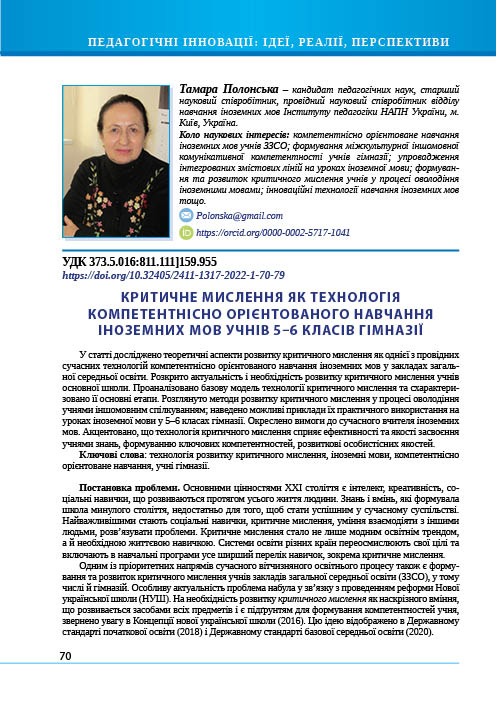Abstract
The article examines the theoretical aspects of critical thinking development as one of the leading modern technologies of competence-oriented teaching foreign languages in institutions of general secondary education. The relevance and necessity for the development of critical thinking to basic school students are reflected in a number of regulations, such as the Concept of the New Ukrainian School, the State Standard of Primary Education, the State Standard of Basic Secondary Education, the foreign language curricula for grades 5–9. In particular, the State Standard of Basic Secondary Education, together with a focus on 11 key competences, provides for the development of 10 cross-cutting skills that are common to all competences. One of these skills is critical and systematic thinking. After analysing a number of definitions of critical thinking, we consider it as a person’s ability to analyse information from a logical standpoint, the ability to make informed decisions and apply the results obtained to solving both standard and non-standard life problems.
The basic model of critical thinking technology is analyzed and its main stages are characterized. The technology of critical thinking uses 3 successive stages: 1) challenge, 2) comprehension, 3) reflection. The challenge stage is the actualization of existing knowledge, the awakening of interest in the topic, the definition of the purpose of studying specific materials. The main task of the comprehension stage is to control the perception and process of learning new material by students themselves. Reflection is a type of thinking aimed at achieving better understanding and leading to new learning. It also provides for determining the achievements of students and the results of the educational activities of the teacher.
Methods of critical thinking development in the process of mastering foreign language communication by students are considered, and potential examples of their practical use in the process of teaching a foreign language in grades 5–6 of gymnasiums are given. The requirements for a contemporary teacher of foreign languages are outlined. It is emphasized that the technology of critical thinking contributes to the efficiency and quality of students’ assimilation of knowledge, the formation of key competences, and the development of personal qualities.
References
Нова українська школа. (2016). Концептуальні засади реформування середньої освіти. МОН України.
Державний стандарт початкової освіти № 87 (2018). https://zakon.rada.gov.ua/laws/show/ 688–2019-%D0%BF
Державний стандарт базової середньої освіти № 898 (2020). https://zakon.rada.gov.ua/ laws/show/898–2020-%D0%BF#n16
Навчальні програми з іноземних мов. 5–9 класи № 804 (2017). https://mon.gov.ua/storage/ app/media/zagalna%20serednya/programy‑5–9-klas/programi-inozemni-movi‑5–9–12.06.2017. pdf /804/17
Редько, В. Г., Шаленко, О. П., Сотникова, С. І., Коваленко, О. Я., Коропецька, І. Б., Якоб, О. М., Самойлюкевич, І. В., Добра, О. М., Кіор, Т. М. Модельна навчальна програма «Іноземна мова. 5–9 класи» для закладів загальної середньої освіти № 795 (2021). https://mon.gov.ua/storage/app/media/zagalna%20serednya/Navchalni.prohramy/2021 /14.07/Model.navch.prohr.5–9.klas.NUSH‑poetap.z.2022/Inozemni.movy.5–9-kl/Inoz.mov.5–9kl.Redko. ta.in.14.07.pdf
Lipman, M. Critical thinking – what can it be? (1995). In A. Ornstein & L. Behar (Eds.), Contemporary issues in curriculum (pp. 145–152). Allyn & Bacon.
Halpern, D. F. (2014). Thought and Knowledge: An introduction to Critical Thinking (5th ed.). Psychology Press.
Пометун, О. І. (2020). Нова українська школа: розвиток критичного мислення учнів початкової школи. Освіта.
Ліпман, М. (2006). Чим може бути критичне мислення. Вісник програм шкільних обмінів. 7. 17–23.
Colley, B. M., Bilics, A. R., & Lerch, C. M. (2012). Reflection: A Key Component to Thinking Critically. The Canadian Journal for the Scholarship of Teaching and Learning, 3 (1). http://dx.doi.org/10.5206/cjsotl-rcacea.2012.1.2
Steele, J.L., Meredith, K.S., Temple, Ch. (2000). Reading and Writing for Critical Thinking. Gloria Publishing.
Nova ukrainska shkola. (2016). Kontseptualni zasady reformuvannia serednoi osvity. MON Ukrainy. (in Ukrainian).
Derzhavnyi standart pochatkovoi osvity № 87 (2018). https://zakon.rada.gov.ua/laws/show/ 688–2019-%D0%BF (in Ukrainian).
Derzhavnyi standart bazovoi serednoi osvity № 898 (2020). https://zakon.rada. gov.ua/laws/ show/898–2020-%D0%BF#n16 (in Ukrainian).
Navchalni prohramy z inozemnykh mov. 5–9 klasy № 804 (2017). https://mon.gov.ua/storage/ app/media/zagalna%20serednya/programy‑5–9-klas/programi-inozemni-movi‑5–9–12.06.2017.pdf /804/17 (in Ukrainian).
Redko, V. H., Shalenko, O. P., Sotnykova, S. I., Kovalenko, O. Ya., Koropetska, I. B., Yakob, O. M., Samoiliukevych, I. V., Dobra, O. M., Kior, T. M. Modelna navchalna prohrama «Inozemna mova. 5–9 klasy» dlia zakladiv zahalnoi serednoi osvity № 795 (2021). https://mon.gov.ua/storage/app/media/zagalna%20serednya/Navchalni.prohramy/2021/14.07/ Model.navch.prohr.5–9.klas.NUSH‑poetap.z.2022/Inozemni.movy.5–9-kl/Inoz.mov.5–9kl. Redko.ta.in.14.07.pdf (in Ukrainian).
Lipman, M. Critical thinking – what can it be? (1995). In A. Ornstein & L. Behar (Eds.), Contemporary issues in curriculum (pp. 145–152). Allyn & Bacon. (in English).
Halpern, D. F. (2014). Thought and Knowledge: An introduction to Critical Thinking (5th ed.). Psychology Press. (in English).
Pometun, O. I. (2020). Nova ukrainska shkola: rozvytok krytychnoho myslennia uchniv pochatkovoi shkoly. Osvita. (in Ukrainian).
Lipman, M. (2006). Chym mozhe buty krytychne myslennia. Visnyk prohram shkilnykh obminiv. 7. 17–23. (in Ukrainian).
Colley, B. M., Bilics, A. R., & Lerch, C. M. (2012). Reflection: A Key Component to Thinking Critically. The Canadian Journal for the Scholarship of Teaching and Learning, 3 (1). http://dx.doi.org/10.5206/cjsotl-rcacea.2012.1.2. (in English).
Steele, J.L., Meredith, K.S., Temple, Ch. (2000). Reading and Writing for Critical Thinking. Gloria Publishing. (in English).

This work is licensed under a Creative Commons Attribution-NonCommercial-ShareAlike 4.0 International License.

